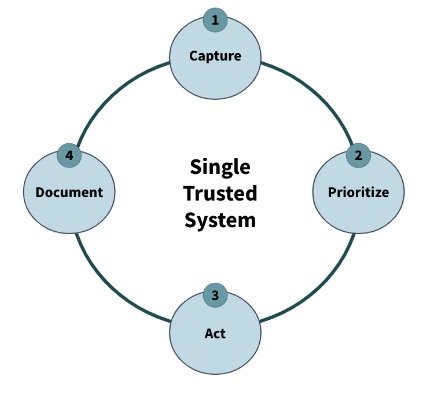Do These 4 Steps to Turn Your Lists into a Real Productivity System
Photo by Ivan Samkov: https://www.pexels.com/photo/person-writing-a-to-do-list-4238511/
You’re a list person! You’re organized!
And yet, you’re still stressed, still time-pressed, still overwhelmed, still exhausted.
Oftentimes people tell me that they are very organized and that they love lists. They’re list makers, they tell me!
And don’t get me wrong; I love a good list.
A list of movies I want to watch
Of books I want to read
My grocery list
There is a place for lists in this world, for sure.
But in terms of getting things done, lists don’t work nearly as well as we think they will.
The same people who tell me they are very organized (and they are, for sure) are often the same people who tell me they are overwhelmed, who tell me they have trouble prioritizing, that sometimes they sit there, staring at the screen, paralyzed, trying to figure out what to do next.
What’s up with that?
What are all these lists for if not to help organized people get shit done?!
Well, here’s the thing: a list is part of a system.
But it isn’t a system on it’s own.
And you, my friend, need a system.
Why is a list different from a system?
A system helps you know what to do right now, factoring in all the areas of your life, your deadlines, etc.
A system drives your work forward like an engine.
But a list?
It’s a repository, a garage.
And most importantly, a list doesn’t help you end your day, and transition into whatever you want to be doing outside of your obligations.
Because in all likelihood, the list will never be complete.
You’ll never get to the end.
So you’ll keep working in vain effort to get it all done.
Or you’ll stop, but feel bad and guilty like you didn’t do enough.
A system, on the other hand, helps you to separate the planning from the doing.
A system adds the dimension of time to a list.
A system helps you to know what you are supposed to be doing, right now.
And a system lets you know when you’re done for the day, so you don’t have to feel guilty about what you didn’t do, and can instead feel great about what you did do, before moving onto the next phase of the day.
A list keeps you feeling defeated; while a system ensures you feel accomplished.
And this is even when you accomplish the same amount of stuff in a given day.
So how do you turn a list into a system?
You can do it in 4 easy steps (and one of them is already done, if you’re a list person):
Capture - This is your list, this is the stuff you need to do, have to do, want to do, might want to do, think you have to do, etc.
Prioritize - This is, crucially, when you’ll do the stuff.
Act - This is doing the stuff (a very important step that’s oft-overlooked).
Document - This is noting what stuff you did and when (so you don’t have to store that in your memory, distracting you from your ability to do the stuff).
When you have a system, you get to practice Task Realism.
You get to give yourself the gift of having an endpoint that you feel good about, every day, while losing track of nothing.
If you don’t separate the planning from the doing and if you just keep adding to a list, one haphazard item at a time, you’ll never feel like you can stop.
A system helps you take control so you can get the important stuff done while also making time for you.
Want a little help turning your lists into a system?
Get on the waitlist for the Time Well Spent Program.
Graduates tell me that creating and implementing a single trusted system is the most impactful thing they've ever done to improve the quality of their lives.



